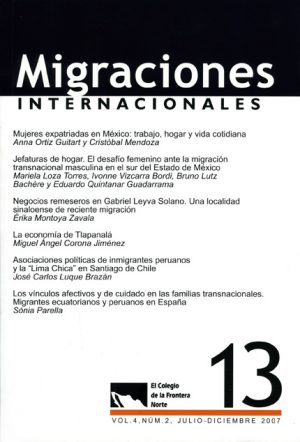Mujeres expatriadas en México: trabajo, hogar y vida cotidiana
DOI:
https://doi.org/10.17428/rmi.v4i13.1165Palabras clave:
migración califi cada, mujeres expatriadas, vida cotidiana, Ciudad de México, EspañaResumen
En este artículo se presentan los resultados de una investigación llevada a cabo con un grupo de mujeres expatriadas españolas residentes en la Ciudad de México. Desde una perspectiva de género, se analizan las experiencias laborales, así como las prácticas cotidianas y espaciales, de un grupo de mujeres de alta califi cación que “acompañan” a sus esposos (o parejas) en el proceso migratorio. Particularmente, se examina cómo se articulan las relaciones de género y las estrategias de negociación dentro de las familias con relación a la nueva posición en el trabajo y en el hogar de estas mujeres.
ABSTRACT
The article presents the results of a study conducted on female Spanish expatriates in Mexico City. From a gender perspective, the article analyzes the labor experiences, as well as the everyday activities and geographical perceptions, of a group of highlyskilled professional women who “accompany” their husbands (or partners) in the migratory process. Specifi cally, it examines the way gender relations are linked to family-based processes of negotiation that are related to women’s new position in both the workplace and the home.
Descargas
Referencias
Anthias, Floya, “Metaphors of Home: Gendering New Migrations to Southern Europe” en Floya Anthias y Gabriella Lazaridis (comps.),
Gender and Migration in Southern Europe: Women on the Move, Oxford,
Berg, 2000, pp. 15-48.
——— y Gabriella Lazaridis, “Introduction: Women on the Move in Southern Europe”, en Floya Anthias y Gabriella Lazaridis (comps.), Gender and Migration in Southern Europe: Women on the Move, Oxford, Berg, 2000, pp. 1-13.
Ariza, Marina, Ya no soy la que dejé atrás: Mujeres migrantes en la República Dominicana, México, D. F., UNAM/Plaza y Valdés, 2000.
Arizpe, Lourdes y Josefina Aranda, “Women Workers in the Strawberry Agriculture in Mexico”, en Eleanor Leacock y Helen I. Safa (comps.), Women’sWork: Development and the Division of Labor and Gender, South Hadley (Massachusetts), Bergin & Garvey Publishers, 1986, pp. 174-193.
Björnberg, Ulla y Kollind, Anna-Karin, “Discurso sobre igualdad de género en dos familias asalariadas. Exploración de aspectos multidimensionales”, en Ángela Meentzen y Enrique Gomáriz (comps.), Democracia de género, una propuesta inclusiva, El Salvador, Fundación Heinrich Böll, 2003, pp. 151-180.
Bonney, Norman y John Love, “Gender and Migration: Geographical Mobility and the Wife’s Sacrifi ce”, The Sociological Review, 39(2), 1991, pp. 335-348.
Boyd, Monica y Deanna Pikkov, Gendered Migration, Livelihood and Entitlements: Migrant Women in Canada and the United States, Ginebra, Research Institute for Social Development (Ocasional Paper, 6), 2005. Disponible en http://www.unrisd.org.
Carrasco, Cristina, “¿Conciliación? No, gracias. Hacia una nueva organización social”, en María Inés Amoroso Miranda, Anna Bosch Pareras, Cristina Carrasco Bengoa, Hortensia Fernández Medrano y Neus Moreno Saenz, Malabaristas de la vida. Mujeres, tiempos y
trabajos, Barcelona, Icaria, 2003, pp. 27-51.
Cavounidis, Jennifer, “Labor Market Impact of Migration: Employment Structures and the Case of Greece”, International Migration Review, vol. 40, núm. 3, agosto de 2006, pp. 635-660.
Chant, Sylvia, “Conclusion: Towards a Framework for the Analysis of Gender-selective Migration”, en Sylvia Chant (coord.), Gender and Migration in Developing Countries, Londres, Belhaven Press, 1992, pp. 197-206.
——— y Sarah A. Radcliffe, “Migration & Development: The Importance of Gender”, en Sylvia Chant (coord.), Gender and Migration in Developing Countries, Londres, Belhaven Press, 1992, pp. 1-29.
Chell, Victoria, “Female Migrants in Italy: Copying in a Country of New Migration”, en Floya Anthias y Gabriella Lazaridis (comps.),Gender and Migration in Southern Europe: Women on the Move, Oxford, Berg, 2000, pp. 49-80.
Cooke, Thomas J., “Family Migration and the Relative Earnings of Husbands and Wives”, Annals of the Association of American Geographers, 93(2), 2003, pp. 338-349.
Cornelius, Wayne, “From Soujournes to Settlers: The Changing Profile
of Mexican Immigration to the United States”, en Jorge A. Bustamante, Clark Reynolds y Raúl Hinojosa Ojeda (comps.), U.S.-Mexico Relations: Labor Market Interdependence, Stanford (California), Stanford University Press, 1992, pp. 155-195.
Decimo, Francesca, “Female Paths of Transnational Migration: Family Networks and the Relative Position of Somali and Moroccan Women in Bologna, Italy”, ponencia presentada en el Encuentro Internacional La Movilidad en Femenino, Tánger, Marruecos, 16-19 de noviembre de 2005.
Donato, Katharine M., “Understanding U.S. Migration: Why some Countries Send Women and Others Send Men”, en Donna Gabaccia (comp.), Seeking Common Ground: Multidisciplinary Studies of Immigrant Women in the United States, Westport (Connecticut), Greenwood Press (Contributions in Women’s Studies, 129), 1992, pp. 159-184.
———, Donna Gabaccia, Jennifer Holdaway, Martin Manalansan y Patricia R. Pessar, “A Glass Half Full?: Gender in Migration Studies”, International Migration Review, vol. 40, núm. 1, 2006, pp. 3-26.
Durand, Jorge, Douglas S. Massey y René M. Zenteno, “Mexican Immigration to the United States: Continuties and Changes”, Latin American Research Review, vol. 36, núm. 1, 2001, pp. 107-127.
Foner, Nancy, “The Immigrant Family: Cultural Legacies and Cultural Changes”, International Migration Review, vol. 31, núm. 4, 1997, pp. 961-974.
———, “Benefi ts and Burdens: Immigrant Women and Work in New York City”, en Rita James Simon (comp.), Immigrant Women, New Brunswick, Transaction Publishers, 2001, pp. 1-20.
Halfacree, Keith, “Household Migration and the Structuration of Patriarchy: Evidence from the USA”, Progress in Human Geography, vol. 19, núm. 2, 1995, pp. 159-182.
———, “A Utopian Imagination in Migration’s Terra Incognita? Acknowledging the Non-economic Worlds of Migration Decisionmaking”, Population, Space and Place, vol. 10, núm. 3, 2004, pp. 239-253.
Hondagneu-Sotelo, Pierrette, Gendered Transitions: Mexican Experiences
of Immigration, Berkeley, University of California, 1994.
———, Doméstica: Immigrant Workers Clearing and Caring in the Shadows
of Affl uence, Berkeley, University of California Press, 2001.
Iredale, Robyn, “Gender, Immigration Policies and Accreditation: Valuing the Skills of Professional Women Migrants”, Geoforum, vol. 36, núm. 2, marzo de 2005, pp. 155-166.
Kofman, Eleonore y Raghuram Parvarti, “Editorial. Gender and Skilled Migrants: Into and Beyond the Work Place”, Geoforum, vol. 36, núm. 2, 2005, 149-154.
Lozano, Fernando, “Migrantes de las ciudades: Nuevos modelos de lamigración mexicana a Estados Unidos”, en Brígida García (comp.), Población y sociedad al inicio del siglo XXI, México, D. F., El Colegio de México, 2002, pp. 241-259.
Mahler, Sarah J. y Patricia R. Pessar, “Gendered Geographies of Power: Analyzing Gender Across Transnational Spaces”, Identities: Global Studies in Culture and Power, vol. 74, núm. 4, 2001, pp. 441-459.
Man, Guida, “Gender, Work and Migration: Deskilling Chinese Immigrant Women in Canada”, Women’s Studies Internacional Forum, vol. 27, núm. 2, 2004, pp. 135-148.
Marcelli, Enrico A. y Wayne Cornelius, “The Changing Profi le of Mexican Migrants to the United States. New Evidence from California and Mexico”, Latin American Research Review, vol. 36, núm. 3, 2001, pp. 105-131.
McDowell, Linda y Gill Court, “Performing Work, Bodily Representations in Merchant Banks”, Environment and Planning D: Society and Space, vol. 12, núm. 6, 1994, pp. 727-750.
Mendoza, Cristóbal, “La migración femenina en el contexto de cambio de patrón migratorio México-Estados Unidos: Aportes de cuatro encuestas mexicanas de los noventa”, ponencia presentada en el Encuentro Internacional La Movilidad en Femenino, Tánger, Marruecos, 16-19 de noviembre de 2005.
——— y Anna Ortiz, “Hacer las Américas: Migrantes españoles de alta calificación en la Ciudad de México”, Documents d’Anàlisi Geogràfi ca, núm. 47, 2006, pp. 93-114.
Momsen, Janet Henshall, “Gender Selectivity in Caribbean Migration”, en Sylvia Chant (comp.), Gender and Migration in Developing Countries, Londres, Belhaven Press, 1992, pp. 73-90.
———, “Maids on the Move”, en Janet Henshall Momsen (comp.), Gender, Migration and Domestic Sector, Londres, Routledge, 1999, pp. 1-21.
Morokvasic, Mirjana, “Birds of Passage are also Women”, International
Migration Review, vol. 18, núm. 4, 1984, pp. 886-907.
Nagel, Caroline, “Skilled Migration in Global Cities from Others’ Perspectives: British Arabs Identity Politics and Local Embededness”, Geoforum, vol. 36, núm. 2, marzo de 2005, pp. 197-210.
Oertzen, Eleonore von, “Cada mujer en su lugar – nueva división internacional del trabajo en la reproducción doméstica”, en Ángela Meentzen y Enrique Gomáriz (comps.), Democracia de género, una propuesta inclusiva, El Salvador, Fundación Heinrich Böll, 2003, pp. 181-197.
Ong, Aiwa, Flexible Citizenship: The Cultural Logics of Transnationality, Durham, Duke University Press, 1999.
Ortiz, Altagracia, “En la aguja y el pedal eché la hiel: A History of Puerto Rican Women in the Garment Industry in New York 1920- 1980”, en Altagracia Ortiz (comp.), Puerto Rican Women and Work: Bridges in Transnational Labor, Filadelfi a, Temple University Press,
, pp. 55-81.
Ortiz, Anna y Cristóbal Mendoza, “Vivir (en) la Ciudad de México: espacio vivido e imaginarios espaciales de un colectivo de migrantes de alta calificación”, Latin America Research Review, 2007 (en prensa).
Pedraza, Silvia, “Women and Migration: The Social Consequences of Gender”, Annual Review of Sociology, vol. 17, 1991, pp. 303-327.
Perista, Heloísa, “EU Migrant Women: Migration, Family Life and Professional Trajectories”, Papers, núm. 60, 2000, pp. 153-166.
Pessar, Patricia R., “On the Homefront and in the Workplace: Integrating Immigrant Women into Feminist Discourse”, Anthropological Quartely, vol. 68, núm. 1, 1995, pp. 37-42.
——— y Sarah J. Mahler, “Transnational Migration: Bringing Gender In”, International Migration Review, vol. 37, núm. 3, 2003, pp. 812-846.
Piper, Nicola, “Gendering the Politics of Migration”, International Migration Review, vol. 40, núm. 1, 2006, pp. 133-164.
Prieto, Yolanda, “Cuban Women in New Jersey: Gender Relations and Change”, en Donna Gabaccia (comp.), Seeking Common Ground: Multidisciplinary Studies of Immigrant Women in the United States, Westport (Connecticut), Greenwood Press (Contributions in Women´s Studies, 129), 1992, pp. 185-201.
Purkayastha, Bandana, “Skilled Migration and Cumulative Disavantage: The Case of Highly Qualifi ed Asian Indian Immigrant Women in the US”, Geoforum, 36, núm. 2, marzo de 2005, pp. 181-196.
Raghuram, Parvati, “The Difference that Skills Make: Gender, Family Migration Strategies and Regulated Labour Markets”, Journal of Ethnic and Migration Studies, vol. 30, núm. 2, 2005, pp. 303-321.
Ribas Mateos, Natalia, Las presencias de la inmigración femenina: un recorrido por Filipinas, Gambia y Marruecos en Cataluña, Barcelona, Icaria, 1999.
Sharpe, Pamela (comp.), Women, Gender and Labour Migration, Londres, Routledge, 2002.
Silvey, Rachel y Victoria Lawson, “Placing the Migrant”, Annals of the Association of American Geographers, vol. 89, núm. 1, 1999, pp. 121-132.
Strum, Philippa y Danielle Tarantolo (eds.), Women Immigrants in the United States, Washington (D. C.), Woodrow Wilson International Center for Scholars, 2003.
Thang, Leng Leng, Elizabeth MacLachlan y Miho Goda, “Expatriates on the Margins – A Study of Japanese Women Working in Singapore”, Geoforum, 33, núm. 4, noviembre de 2002, pp. 539-551.
Willis, Katie y Brenda S.A. Yeoh, “Gendering Transnational Communities: A Comparison of Singaporean and British Migrants in China”, Geoforum, 33, núm. 4, noviembre de 2002, pp. 553-565.
Yeoh, Brenda S.A. y Louisa-May Khoo, “Home, Work and Community: Skilled International Migration and Expatriate Women in Singapore”, International Migration, vol. 36, núm. 2, 1998, pp. 159-186.
Yeoh, Brenda S.A., Shirlena Huang y Katie Willis, “Global Cities, Transnational Flows and Gender Dimensions, The View from Singapore”, Tijdschrift voor Economische en Sociale Geografi e, vol. 91, núm. 2, 2000, pp. 147-158.
Yeoh, Brenda S.A. y Katie Willis, “Singaporeans in China: Transnational Women Elites and The Negotiation of Gendered Identities”, Geoforum, 36, núm. 2, marzo de 2005a, pp. 211-222.
———, “Singaporean and British Transmigrants in China and the Cultural Political of ‘Contact Zones’”, Journal of Ethnic and Migration Studies, vol. 31, núm. 2, 2005b, pp. 269-285.
Fecha de recepción: 26 de abril de 2007
Fecha de aceptación: 6 de agosto de 2007
Descargas
Publicado
Número
Sección
Licencia
Las/los autoras/es que publiquen en esta revista aceptan las siguientes condiciones:
- Las/los autoras/es conservan los derechos de autor y ceden a la revista Migraciones Internacionales (RMI) el derecho de la primera publicación, mediante el registro de los textos con la licencia de Creative Commons Atribución-No comercial-Sin derivar 4.0 internacional (CC BY-NC-ND 4.0), que permite a terceros utilizar lo publicado siempre que mencionen la autoría del trabajo y a la primera publicación en esta revista.
- Autorizan que su artículo y todos los materiales incluidos en él sean reproducidos, publicados, traducidos, comunicados y transmitidos públicamente en cualquier forma o medio; así como efectuar su distribución al público en el número de ejemplares que se requieran y su comunicación pública, en cada una de sus modalidades, incluida su puesta a disposición del público a través de medios electrónicos o de cualquier otra tecnología, para fines exclusivamente científicos, culturales, de difusión y sin fines comerciales.
- Los autores/as pueden realizar otros acuerdos contractuales independientes y adicionales para la distribución no exclusiva de la versión del artículo publicado en esta revista (por ejemplo: incluirlo en un repositorio institucional, página web personal; o bien publicarlo en un libro) siempre que sea sin fines comerciales e indiquen claramente que el trabajo se publicó por primera vez en Migraciones Internacionales (RMI), [agregando la ficha bibliográfica correspondiente: Autor/es. (año). Título del artículo. Migraciones Internacionales, volumen (número), pp. doi: xxxx ].
Para ello, las/los autoras/es deben remitir el formato de carta-cesión de la propiedad de los derechos de la primera publicación debidamente llenado y firmado. Este documento debe cargarse en formato PDF en archivos complementarios dentro de la plataforma OJS.
Este obra está bajo una licencia de Creative Commons Atribución-No comercial-Sin derivar 4.0 internacional (CC BY-NC-ND 4.0)..













